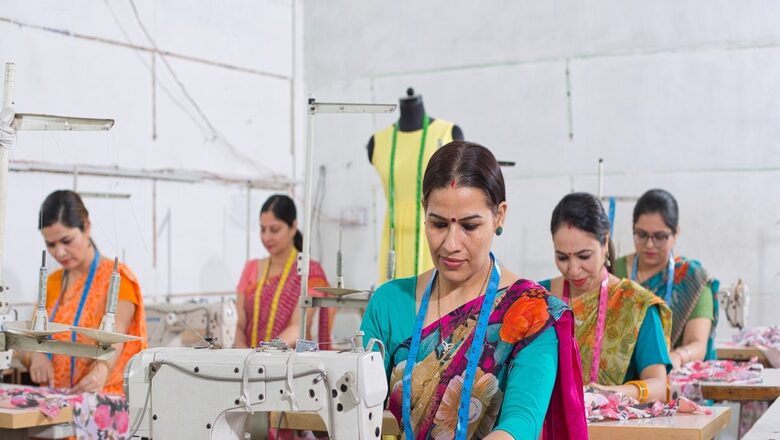
views
The Pradhan Mantri Kaushal Vikas Yojana (PMKVY), launched in 2015, has trained 13.7 million candidates over seven years. However, only 18 per cent or 2.4 million of these candidates have been successful in securing a job. This low placement rate is one of several concerning issues highlighted by a Lok Sabha standing committee. The committee also identified underutilised funds, infrastructure deficiencies, dropouts, a disconnect with industry, and insufficient state engagement as significant problems. To increase the effectiveness of the program, PMKVY must be aligned with the local economy’s needs.
Currently, only 2.4 per cent of India’s 530-million-strong workforce has received formal vocational education or training. This means that a vast majority of the workforce remains unskilled, making them less productive. Additionally, a quarter of India’s workforce has less than primary education, further emphasising the importance of skill development programs in reducing unemployment rates. Despite this, the latest data from the quarterly Periodic Labour Force Survey (PLFS) reports an unemployment rate of 6.8 per cent, with a youth unemployment rate (for ages 15 to 29) of 17.3 per cent.
The PMKVY has undergone three versions, with PMKVY 2.0 having the highest number of trained and placed candidates, with a placement rate of 19.5 per cent. However, this rate has since fallen to 5.8 per cent for PMKVY 3.0, the lowest yet. Overall, approximately 11 million trained candidates have completed certification. It is imperative that the government takes immediate action to address these concerns, align PMKVY with the local economy, and improve the program’s effectiveness.
Uttar Pradesh is the state with the highest number of candidates trained, with a staggering 1.59 million individuals, however, the placement rate in the state is only a meagre 20 per cent. On the other hand, Telangana takes the lead with the highest placement rate of 35.1 per cent, followed closely by Puducherry at 34.6 per cent. Haryana and Punjab are not far behind with placement rates of 31.7 per cent and 29.6 per cent respectively. Maharashtra and Kerala, however, need to work on their placement rates, as they stand at a disappointing 9.3 per cent and 10.4 per cent respectively.
It should be noted that the National Skill Development Corporation (NSDC) primarily partnered with private vocational training providers due to the lack of private Industrial Training Institutes (ITIs) at the time. However, the shorter training duration of NSDC courses (3-4 months) compared to the 1-2 year programmes offered by ITIs is a major challenge that needs to be addressed.
Poor utilisation of funds
According to government data, the programme’s fund utilisation was poor in 2016-17, with only 56 per cent of the allocated funds being used. Although the number improved to 98 per cent in 2020-21, it fell back to 72 per cent in 2021-22. The Lok Sabha standing committee reported that the suspension of training and placement operations due to Covid restrictions led to a significant drop in enrolment and certification, resulting in low disbursement and utilisation of funds. However, it is expected that the ongoing training under PMKVY 4.0 since January 2023 will lead to an increase in expenditure upon its completion.
Connect to industry is missing
NSDC, established in 2008, collaborates with partner trainers to conduct skill development programmes. However, the lack of industry participation and a disconnect between NSDC and the industry is a significant challenge that needs to be addressed. The current skill development programmes do not align with the actual regional demand for skills, creating a mismatch between training and local economic needs. This leads to a gap between the skills imparted and the market requirements, which is unacceptable.
The quality of training and the choice of the particular skill being imparted must meet the market standards. Unfortunately, the skill centres are not adequately equipped for practical training, resulting in theoretical training with little practical exposure. Immediate action needs to be taken to bridge this gap. The Lok Sabha’s standing committee has also highlighted this disconnect and suggested conducting a survey of industry representatives to better understand their needs. It is time to take the necessary steps to ensure that the skill development programmes align with the industry needs and bridge the gap between the skills imparted and the market requirements.
Candidate dropout, infra deficiencies
A study conducted by the Indian Institute of Public Administration between 2016 and 2021 revealed that 20 per cent of candidates who enrolled under PMKVY dropped out. The reasons for this were medical issues, family obligations, social challenges, lengthy commutes to training centres, marital status changes, increased livelihood demands, limited job opportunities, and perceived skill stagnation. Female candidates also dropped out due to pregnancy, marriage, and course duration.
The standing committee noted that the Ministry needs to take immediate action to address the factors that led to candidate dropouts, such as distance to training centres and accessibility to jobs. For the female dropouts, the committee suggested that the Ministry should collaborate with ASHA and Anganwadi centres to create awareness about the benefits of skilling and encourage them to resume training as soon as possible after delivery.
It is unacceptable that out of 818 Pradhan Mantri Kaushal Kendras (PMKKs) or training centres allocated in all districts of India, only 722 have been established so far. Of the remaining, 58 PMKKs were surrendered to the government by private vendors due to operational difficulties. This is a significant issue and requires immediate attention from the government. The lack of eligible trainers is another issue that is preventing many centres from becoming operational. As a solution, the government must create a pool of national assessors and trainers under PMKVY 4.0. The government must take necessary actions to ensure that the PMKVY program is successful in creating a skilled workforce and reducing unemployment in India.
Limited state participation
State disparities driven by varying economic and employment histories result in limited state participation. This is a significant challenge that needs to be addressed with a sense of urgency. For instance, while some states have a significant agricultural workforce that relies on programmes like the Mahatma Gandhi National Rural Employment Guarantee Scheme, others like Maharashtra or Tamil Nadu have more employment opportunities. Therefore, it is imperative to adopt localised, demand-driven approaches that extend employment schemes from metropolitan areas to tier-2 and tier-3 cities, thus addressing specific regional challenges.
In 2016-20, PMKVY 2.0 introduced state participation to enhance support and monitoring and enable targeted training that aligns with local needs and aspirations. However, the state-managed model encountered several issues, including delays in the release of funds from the state treasury to respective departments, a shortage of trainers with the necessary eligibility criteria, a lack of available placement partners, and delayed payments to training partners. These issues need to be addressed immediately to ensure that the programme is efficient in achieving its objectives.
Moreover, the online management system for the state-managed component was operational in only 15 states and union territories, and this has affected coordination with the Union government. It is imperative to expand this system to all states and union territories to ensure that the programme runs smoothly.
In conclusion, enhancing the programme’s effectiveness and aligning PMKVY with the industry to match local economic needs is crucial to making skill training programmes employable. It is time to take bold steps to address the challenges facing the programme and ensure that it achieves its objectives.
The writer is a Co-Founder and MD of Orane International, a Training Partner with the National Skill Development Corporation (NSDC), and a Network Member of India International Skill Centres, (an initiative of GoI). Views expressed in the above piece are personal and solely that of the author. They do not necessarily reflect News18’s views.




















Comments
0 comment